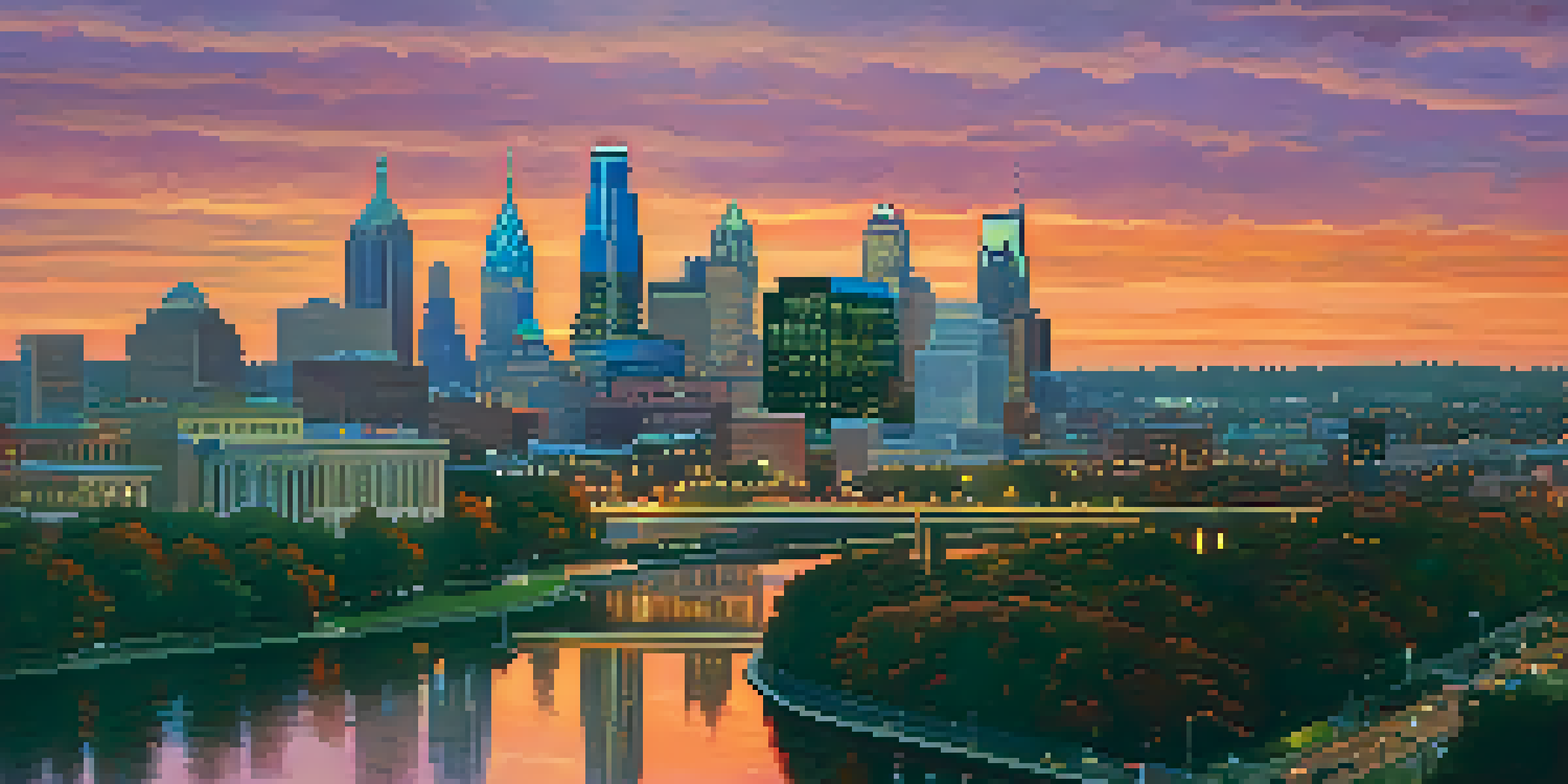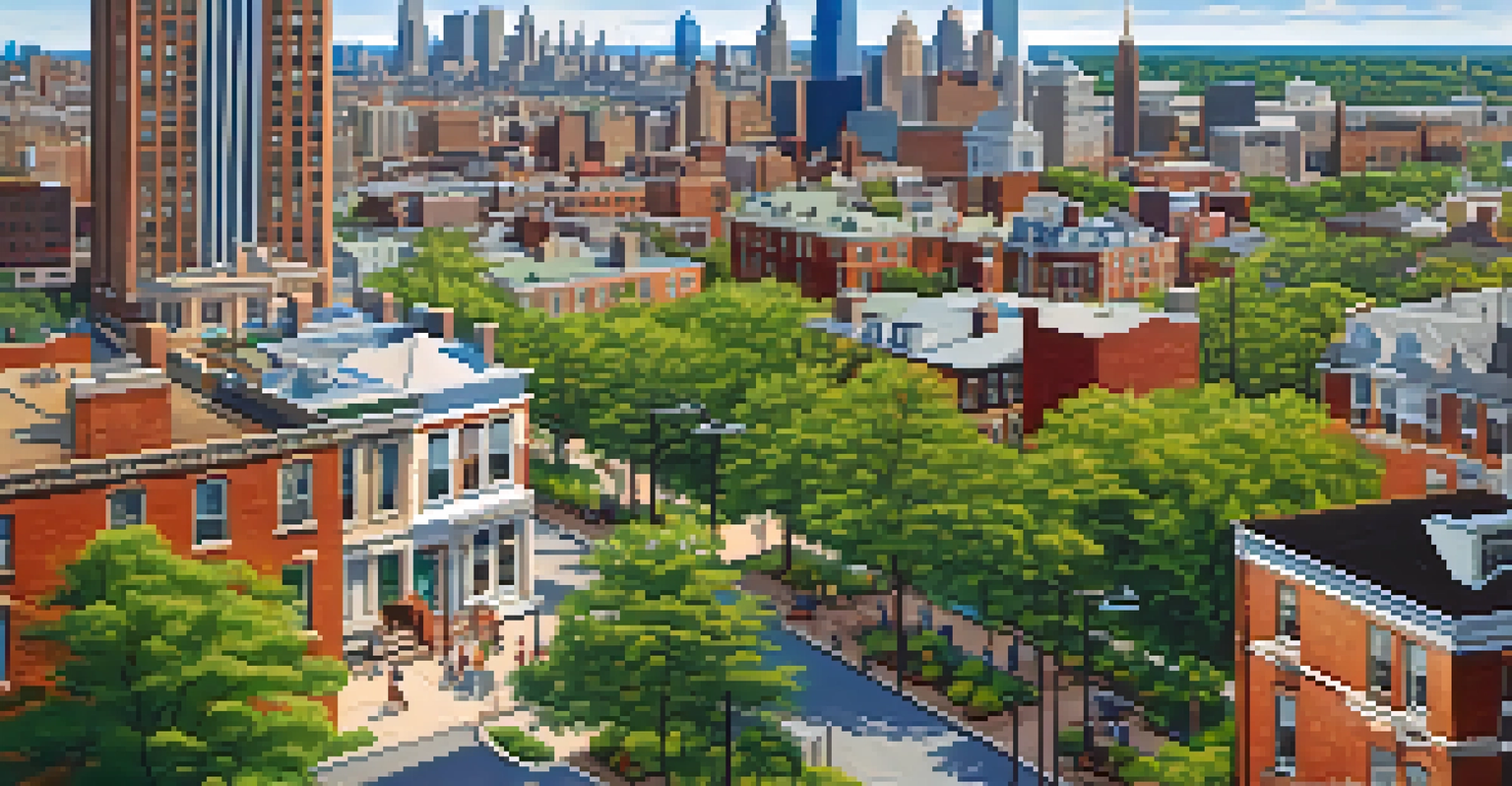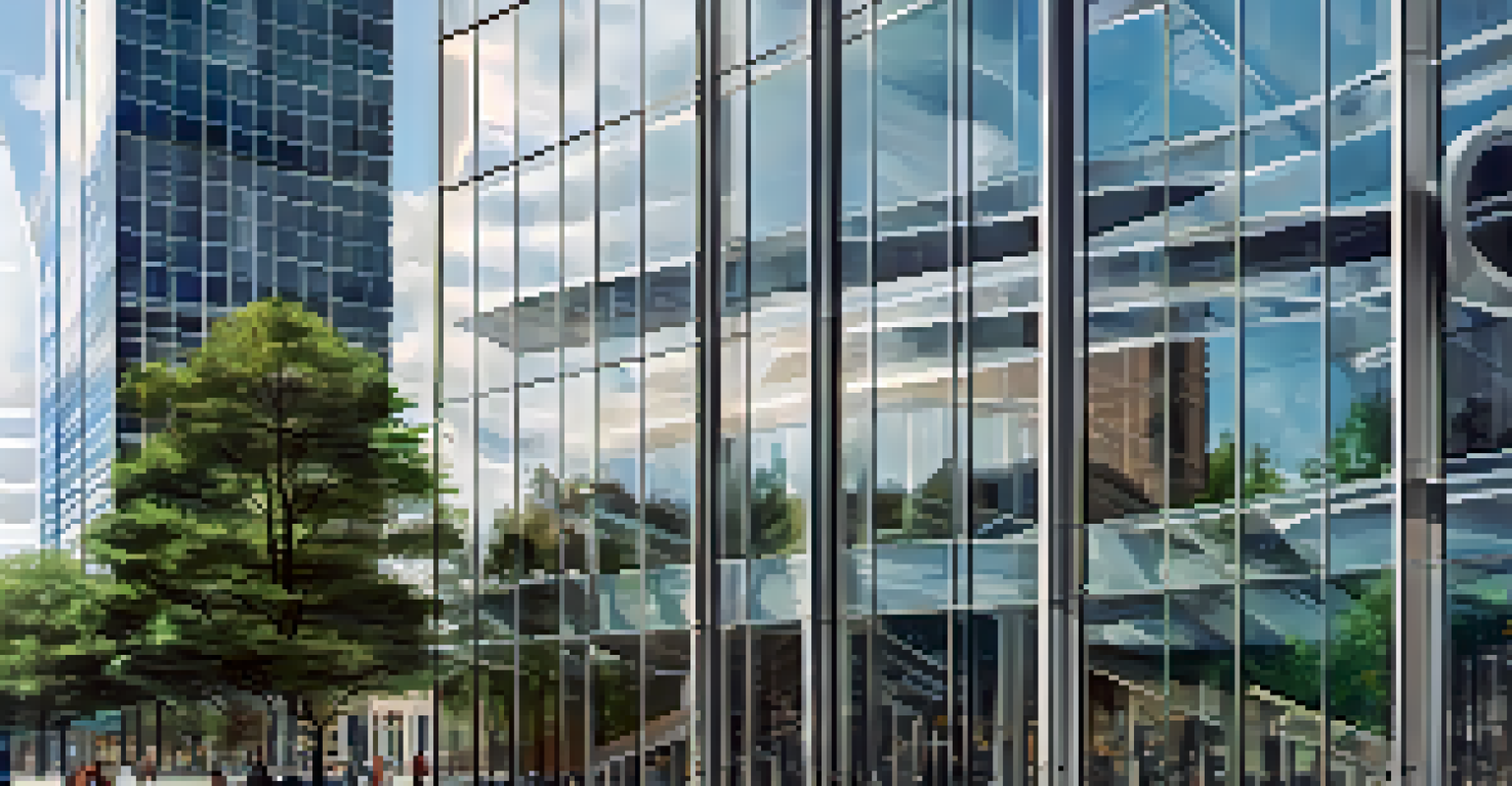The Impact of Urban Development on Philadelphia's Skyline

The Evolution of Philadelphia's Skyline Over the Years
Philadelphia's skyline has undergone a remarkable transformation over the decades, evolving from a collection of modest buildings to a breathtaking array of skyscrapers. This evolution reflects not just architectural trends but also the city's economic and cultural shifts. For example, the rise of the Liberty Place towers in the 1990s marked a significant change, symbolizing Philadelphia's resurgence as a modern metropolis.
Architecture is the learned game, correct and magnificent, of forms assembled in the light.
As new buildings replaced older structures, the skyline started to tell a story of progress and innovation. The addition of contemporary designs like the Comcast Center highlighted the city’s ambition to compete with other major U.S. cities. Each new construction project brought its own unique flair, contributing to a diverse architectural palette that represents Philadelphia's rich history.
Moreover, this evolution is more than just about aesthetics; it plays a crucial role in shaping the city's identity. The skyline now serves as a backdrop for events and festivals, embodying the spirit of Philadelphia and its residents. As we continue to witness new developments, it becomes essential to appreciate how these changes influence both the skyline and the community.
Key Architectural Landmarks and Their Significance
Philadelphia is home to several iconic landmarks that define its skyline, each with a unique story and architectural style. Structures like the Philadelphia Museum of Art and Independence Hall are not just historical sites; they are essential pieces of the city's identity. Their presence amidst modern skyscrapers creates a fascinating juxtaposition that reflects Philadelphia’s rich history.

The Comcast Center, the tallest building in Philadelphia, symbolizes the city’s commitment to innovation and growth. Its sleek glass facade and cutting-edge design encapsulate what it means to be a modern urban center. Similarly, the One Liberty Place, once the tallest building in the city, changed the skyline and also the perception of Philadelphia as a business hub.
Philadelphia's Skyline Transformation
The skyline reflects Philadelphia's evolution from modest buildings to a modern urban center, showcasing architectural innovation and cultural growth.
These landmarks not only enhance the visual appeal of the skyline but also serve as focal points for both locals and visitors. They draw people in, encouraging exploration and appreciation of the city’s heritage. Understanding the significance of these structures helps us connect with Philadelphia’s past and envision its future.
The Role of Urban Planning in Shaping the Skyline
Urban planning plays a pivotal role in determining the layout and design of Philadelphia's skyline. City planners are tasked with balancing the need for growth with preserving historical significance, which can be quite a challenge. For instance, zoning laws dictate where high-rises can be built, ensuring that the skyline maintains a harmonious blend of old and new architecture.
The best way to predict the future is to build it.
In recent years, there has been a push for sustainable development practices that not only enhance the skyline but also protect the environment. Projects like the Schuylkill Yards development aim to create green spaces alongside skyscrapers, promoting a healthier urban lifestyle. This focus on sustainability is a testament to how urban planning can benefit both the skyline and the community.
Moreover, public input has become increasingly important in the planning process. Engaging residents in discussions about urban development fosters a sense of ownership and responsibility towards the city’s landscape. As Philadelphia continues to grow, thoughtful planning will be essential in preserving its unique skyline while accommodating the needs of its residents.
Challenges Faced by Urban Developers in Philadelphia
Urban developers in Philadelphia face a multitude of challenges that can complicate the construction process. One significant hurdle is the city’s strict preservation laws, which protect historic sites from being overshadowed by modern developments. This ensures that the skyline remains a blend of the past and present, but it can also slow down new projects and increase costs.
Additionally, navigating the complex regulatory landscape can be daunting for developers. Obtaining the necessary permits and approvals requires patience and thorough understanding of city regulations, which can vary widely. These bureaucratic challenges often lead to delays, impacting the overall timeline of urban development projects.
Importance of Community Engagement
Involving local residents in urban development fosters a sense of belonging and ensures new projects align with community needs.
Finally, community opposition can also pose obstacles. Residents may resist changes to their neighborhoods, fearing that new developments will disrupt the local culture or lead to gentrification. Developers must find ways to address these concerns through open dialogue and collaboration, ensuring that the skyline reflects the aspirations of all Philadelphians.
The Impact of Technology on Urban Development
Technology has dramatically transformed urban development in Philadelphia, influencing both the construction process and building design. Innovations such as Building Information Modeling (BIM) allow developers to create more efficient and sustainable structures. This technology enables better planning, reducing waste and improving energy efficiency, which is crucial for modern urban centers.
Furthermore, advancements in construction materials and techniques have paved the way for taller and more complex buildings. For instance, the use of high-performance glass and lightweight steel has allowed architects to push the limits of traditional design, resulting in striking structures that redefine the skyline. These materials not only enhance aesthetics but also contribute to energy conservation.
Additionally, technology plays a vital role in creating smart buildings that enhance the quality of urban life. Features such as automated systems for lighting and climate control support sustainability goals and provide comfort to occupants. As Philadelphia embraces these technological advancements, the skyline will continue to evolve, reflecting a commitment to innovation and modern living.
Community Engagement in Urban Development Projects
Community engagement is an essential aspect of urban development, particularly in a city like Philadelphia with its rich tapestry of neighborhoods. Developers are increasingly recognizing the importance of involving local residents in the planning process. This collaboration helps ensure that new projects align with the community's needs and desires, fostering a sense of belonging.
For instance, public meetings and workshops provide platforms for residents to voice their opinions and share their visions for the future of their neighborhoods. Engaging the community not only builds trust but also enhances the overall project by incorporating diverse perspectives. When residents feel heard, they are more likely to embrace new developments and see them as assets rather than threats.
Future Trends in Urban Development
The skyline will increasingly feature mixed-use developments and sustainable designs, highlighting Philadelphia's commitment to innovation and environmental responsibility.
Moreover, successful community engagement can lead to the creation of public spaces that enhance the skyline and improve the quality of life. Parks, plazas, and art installations can complement urban developments, creating vibrant areas for social interaction. Ultimately, prioritizing community voices in development projects will help shape a skyline that reflects Philadelphia's unique character and values.
The Future of Philadelphia's Skyline: Trends and Predictions
As we look to the future, several trends are shaping the trajectory of Philadelphia’s skyline. One notable trend is the increasing emphasis on mixed-use developments, where residential, commercial, and recreational spaces coexist. This approach not only maximizes land use but also fosters vibrant communities that enhance urban life.
Another trend is the growing focus on sustainability and green architecture. Developers are prioritizing eco-friendly materials and designs that reduce carbon footprints and promote energy efficiency. As awareness of climate change continues to rise, we can expect to see more buildings incorporating green roofs, solar panels, and other sustainable features, transforming the skyline into a symbol of environmental responsibility.

Lastly, the integration of technology into urban design will likely continue to influence the skyline's evolution. Smart technologies that enhance connectivity and improve living conditions will become more prevalent, creating a dynamic urban landscape. With these trends in mind, Philadelphia's skyline is poised to remain a vibrant and evolving reflection of its community and aspirations.